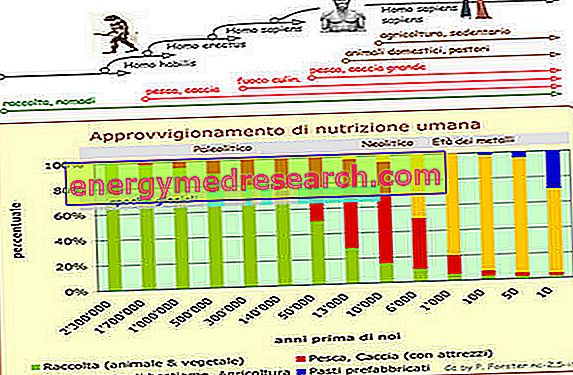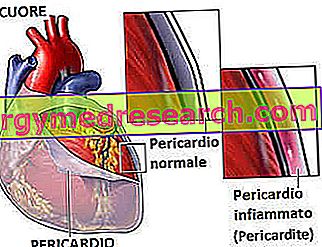Generality
Gastrinemia is the measure of gastrin concentration in the blood .
This exam is useful in evaluating subjects who have peptic ulcer and / or other severe symptoms, such as abdominal pain, stomach acidity and recurrent diarrhea.

The determination of gastrinemia is prescribed by the doctor mainly as a support in the diagnosis of gastrin-secreting tumors (called "gastrinomas"), Zollinger-Ellison syndrome (ZE) and hyperplasia of G. cells.
What's this
Gastrin is a hormone produced by endocrine G cells, which are found scattered in the gastric and duodenal mucosa. Its main function is to regulate the production of acid in the stomach during digestion.
Gastrin exists in different forms, which differ in the length and number of amino acids they contain.
Gastrin secretion during the digestion process is controlled by various hormonal and chemical factors. Under normal conditions:
- Gastrin acts by stimulating the motility of the pylorus and induces the secretion of hydrochloric acid at the gastric level;
- In turn, hydrochloric acid acts with a negative retrograde control mechanism on gastrin production. In practice, the progressive increase in gastric acidity leads to a reduction in gastrin production.
Why do you measure
The determination of the amount of gastrin in the blood is indicated in the diagnosis of diseases characterized by hypergastrinemia and gastric acid hypersecretion, including:
- Zollinger-Ellison syndrome (rare disease of the gastrointestinal tract characterized by severe and recurrent peptic ulcers on the stomach and duodenum);
- G-cell hyperplasia (increase in the number of specialized stomach cells that produce gastrin).
This test is also indicated for the monitoring of relapses after surgical removal of a gastrinoma (gastrin-secreting tumor, located mainly in the pancreas).
When is the exam prescribed?
The extent of gastrinemia is indicated when the doctor suspects that the peptic ulcer and / or episodes of diarrhea and abdominal pain manifested by the patient may be associated with excessive gastrin production.
Furthermore, gastrinemia can be determined periodically if monitoring of gastrinoma recurrences is necessary.
Other associated exams
Gastrinemia alterations are also found in other pathological conditions, such as pernicious anemia and pyloric obstruction. Therefore, before making the definitive diagnosis of gastrinoma, a confirmation test is required which involves the determination of the gastrin level following a secretin injection . The latter, produced by the small intestine, has the function of inhibiting the production of gastrin.
In the case of gastrinoma, the level of gastrin remains high, even after secretin administration.
Further confirmation is provided by imaging examinations (ultrasound, CT and MRI), useful for locating the site of the neuroendocrine tumor and any metastases, and for diagnostic biopsy.
Normal values
The normal values of gastrinemia are generally lower than 200 pg / mL, although this reference may vary slightly from laboratory to laboratory.
Adults: | Minor (<) 200 picograms per milliliter (pg / mL) not fasting or <95 picomoles per liter (pmol / L) fasting |
Children: | <125 pg / mL or <60 pmol / L |
The concentration of gastrin in the blood increases physiologically with advancing age and when people undergo non-fasting examination. It should also be noted that gastrinemia follows a circadian rhythm: the haematic concentration of gastrin is minimal between 3 and 7 am and increases with fluctuations during the day, especially in relation to meals.
Gastrinemia Alta - Causes
Excessive gastrin production may indicate the presence of diseases such as:
- Zollinger-Ellison syndrome;
- G-cell hyperplasia;
- Gastrin-secreting tumor (gastrinoma).
Elevated levels of gastrinemia can be observed in patients with:
- Massive intestinal resection;
- Chronic renal failure;
- Hyperparathyroidism.
Other conditions in which hyper stricture may occur include:
- Gastric atrophy;
- Pernicious anemia;
- Pyloric obstruction (blockage at the junction between the stomach and the duodenum).
Low gastrinemia - Causes
A low level of gastrin (hypogastrinemia) can be found in the presence of hypothyroidism (reduced thyroid activity).
However, as a rule, low or normal concentrations of gastrin are not worrying.
How to measure it
Gastrin levels in the blood (gastrinemia) can be measured by a common laboratory blood test.
The dosage of gastrinemia is part of the so-called gastropanel, a test conducted on a normal blood sample in order to determine the health of the gastric mucosa through the determination of four parameters:
- Gastrin 17 basal (2 ÷ 10pmol / l);
- Pepsinogen I (30 ÷ 120μg / l);
- Pepsinogen II (3 ÷ 10 μg / l);
- IgA / IgG antibodies to H. pylori (0 ÷ 30 EIU)).
Preparation
Before performing any diagnostic test, antacid therapy should be suspended, which can distort both basal levels and the response of gastrin to stimuli. In particular, proton pump inhibitors must be suspended for 5-7 days and the H2 antagonists for 24-48 hours. It is also important to conduct the fasting test for at least 12 hours (also avoiding chewing gum), abstaining from the consumption of alcohol in the 24/48 hours prior to the test and from cigarette smoking in the preceding 4 hours.
Stress can also invalidate the results of the exam, which is why the doctor may request you to stay for half an hour in the waiting room in order to "dispose" of any stress relieving.
Interpretation of Results
Baseline gastrin values greater than 450/500 pg / mL, in a patient with gastric pH <2, allow the diagnosis of gastrinoma.
However, when gastrinemia is only moderately high (between 200 and 500 pg / mL) it is essential to demonstrate acid hypersecretion (MAO / BAO ratio, or Maximal Acid Output / Basal Acid output) and perform a stimulus test with secretin. During this examination, the synthetic form of this duodenal hormone with strong stimulatory power on duodenal and pancreatic secretion (possible sites of gastrinoma) is injected intravenously.
In normal subjects and in gastroresecated ones, secretin does not cause any significant increase in gastrinemia.
In contrast, an increase in circulating gastrin levels above 200 pg / mL, within 10 minutes of the stimulus, is diagnostic for Zollinger and Ellison syndrome (gastrinoma).
Instead of secretin a calcium infusion can be practiced or a protein meal is ingested (in the latter case the increase in gastrinemia in the presence of gastrinoma is modest compared to normal subjects, and even more compared to those with hyperplasia of G cells).
The pH-metry, that is the measurement of gastric pH, can be useful to diagnose atrophic gastritis, which unlike other conditions is characterized by a more or less marked hypochloridria.
Low levels of gastrin (hypogastrinemia) can be recorded in the presence of hypothyroidism (reduced thyroid activity).



